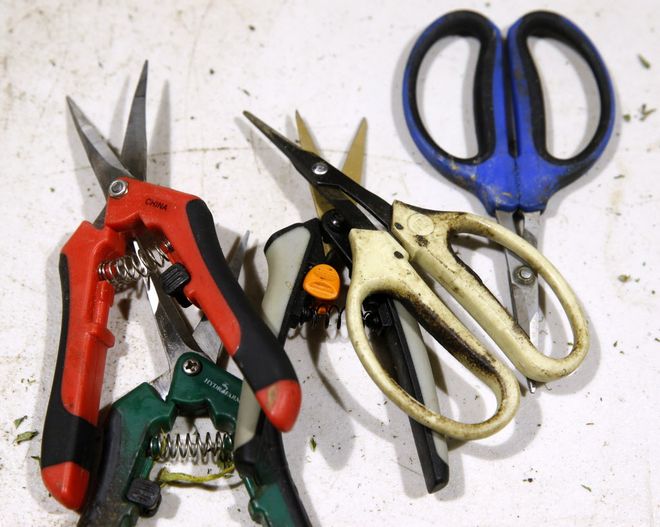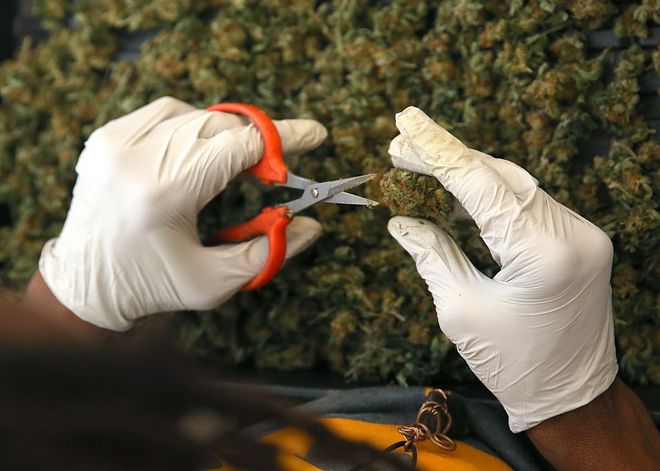Bay Area artists’ lucrative, secret side-gig: part-time trimmers

In a 2016 interview with media personality DJ Vlad, Anderson Paak admitted that before he was a Grammy-nominated artist, he was using scissors to take the leaves off of cannabis buds — a process called ‘“trimming” — to make a living.
“That s— helped me tremendously,” he said. “It was cash under the table.”
In the cannabis industry, trimmers are the workers who manicure buds, removing extra leaf matter to optimize quality. And, like Paak, many Bay Area artists view trimming as a lucrative and relatively low-commitment gig that provides them with enough cash to pay their bills and still have time to pursue creative projects. It’s the difference between earning $15 an hour ($120 a day before taxes) and taking home $250 a day in untaxed cash.
During the fall harvest season, trimmers from all over California travel to the cultivation heartlands of Humboldt and Mendocino counties to live and work at pot farms, staying from a week to several months. And around the Bay Area, indoor grow operations offer year-round, flexible, part-time gigs. These jobs are often informal and off-the-books: Trimmers tend to find out about them through word of mouth and get paid in cash for each pound trimmed.
Because California’s commercial legalization rules have yet to be implemented, many aspects of the industry are still in a legal gray area. And although there haven’t been any formal studies on the cannabis industry’s labor force, people familiar with the industry say that artists make up a substantial percentage of trimmers in the Bay Area and the Emerald Triangle.
“From my time spent trimming — whether at various scenes or within the comforts of more familiar confines — almost every single person I knocked out a harvest with was an artist,” said Erin Jacobs, an art curator and burlesque dancer a.k.a. Sugar Cane Jane. Jacobs has been working in cannabis for five years and is a “trim mom” — an industry term for someone who oversees trimmers — at a farm in the Emerald Triangle.
Trimming often appeals to artists because it’s hands-on, meditative work — not unlike sculpting or painting.
“My personal attraction to the industry boils down to creating with my hands and being able to use them as tools to cultivate a life for my family and myself,” said Jacobs, adding that trimming in a room full of artists can also be a source of creative inspiration. “It’s truly awesome, there’s a literal force in the room that I find to be incredibly stimulating as an artist.”
But not all artists who trim share this optimistic view. Brontez Purnell, an Oakland musician, author and dancer, explained that Bay Area artists often trim out of necessity because of the region’s expensive living costs.
“When I first moved here, I thought you could get a restaurant job to reasonably pay your rent and just scrape by, and that’s not the case anymore,” said Purnell, who moved to Oakland from Alabama nearly 15 years ago. “So seasonal work comes up and you’re in between jobs so you kind of have to go do it and make money.”
But why trimming and not more legit independent contractor gigs like driving for Uber or doing Postmates deliveries?
For one: Trimming is pretty artist-friendly. Trimmers generally get to set their hours, work as long as they want, wear what they want, listen to whatever music they want and smoke all the pot they can handle. It can also pay better.
“I could not sustain my art and drive an Uber for 12 hours a day,” said Purnell. “I feel like going up to trim for a month or two will give you three months of leniency” to focus on art.
However, Purnell and other industry insiders say that as supply increases in the new, recreational market, cannabis will decrease in value — and so will trimmers’ labor. “Everywhere I know now, you get $150 a pound, whereas before it was $225,” he said.
Nina Parks, co-founder of Supernova Women, a Bay Area advocacy group for people of color in the cannabis industry, said that more and more farmers are buying trimming machines to cut labor costs.
“Trimming is gonna become a minimum wage job in the new market. People are trying to maximize the profits,” she explained. The communal culture of some cannabis farms — where trimmers live, eat and work together in a co-op-style environment — will also no longer be sustainable. “Having livable accommodations on a farm is expensive.”
Once recreational marijuana is fully legal in 2018, trimmers will be subject to the same regulations as any other workforce — meaning their pay will be on the books and their income taxed — unless they stay in the black market.
Parks fears that as trimming gigs become less lucrative, artists in search of flexible, part-time jobs will turn to more dangerous, black-market work to afford living in the Bay Area.
“There’s always going to be a black market because that’s where people can find a livelihood,” she said.
Expensive rents in San Francisco and Oakland are already a huge challenge for both cities’ once-thriving creative communities. A 2015 survey from the San Francisco Arts Commission confirmed that nearly 70 percent of artists had been recently displaced from their homes or work spaces. And if trimming becomes one less option to make a livable wage? Purnell warns, “I think a lot more people will be broke and we’ll see a lot more people leave this place.”
Nastia Voynovskaya is KQED’s music editor.

